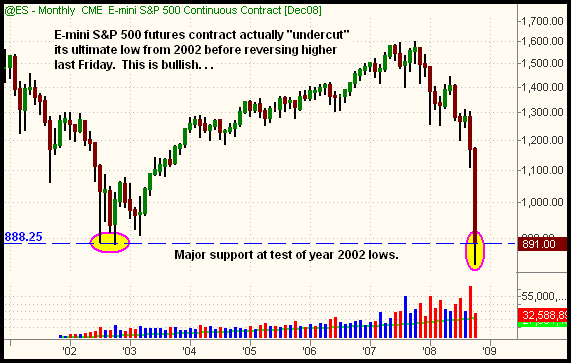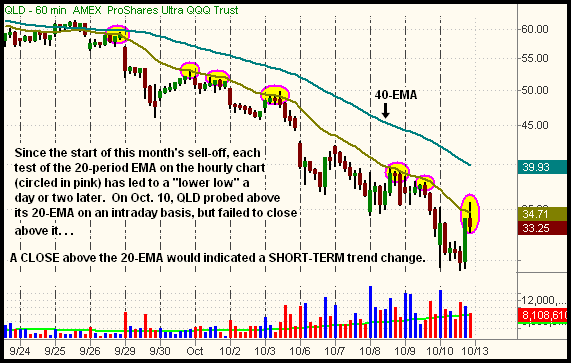|
The Wagner Daily ETF Report For October 13
Stocks concluded one of the worst weeks in history with a frenzied pace of trading that led to mixed results in the major indices. After opening lower, then trending south throughout most of the day, the main stock market indexes were on pace for another session of massive declines last Friday. However, the bulls finally stepped in and aggressively propelled stocks higher in the final hour of trading. The S&P 500 finished the day 1.2% lower and the Dow Jones Industrial Average lost 1.5%, but that was much better than the respective losses of 7.7% and 8.1% the indices were showing at their intraday lows. The Nasdaq Composite fared even better by eking out a closing gain of 0.3%. Curiously, small-cap stocks showed massive relative strength, enabling the Russell 2000 Index to leap 4.7%. The S&P Midcap 400 Index ticked 0.2% higher. The S&P 500 and Dow Jones Industrial Average closed just above the middle of their intraday trading ranges, as the rest of the main stock market indexes finished in the upper third of their ranges.
The most notable facet of last Friday's trading was the frantic turnover. Total volume in the NYSE rocketed 52% above the previous day's level, while volume in the Nasdaq zoomed 41% higher. Despite the already brisk activity of recent weeks, turnover in both exchanges shot to the highest levels of the year last Friday, and also nearly doubled 50-day average volume levels. With just over 4 billion shares changing hands, the Nasdaq registered one of its most active days in history. This hectic pace of trading was bullish because it occurred as the major indices staged an impressive late-day reversal. Still, caution is required because there have been at least two other instances in recent weeks where stocks showed signs of "capitulation" by reversing on sharply higher volume, only to get slammed to new lows the following day. We can't say this time was different unless the stock market actually follows through to close with a solid session of gains today.
In the October 10, 2008 issue of The Wagner Daily, we used the long-term monthly chart of the S&P 500 to show how the index was quickly approaching major support of its year 2002 lows. Before the S&P 500 recovered into last Friday's close, the index had dropped to within just 3% (25 points) of its monthly closing low of September 2002. But those of you who trade futures contracts may have noticed that the E-mini S&P 500 (@ES), which trades continuously around the clock, actually did "undercut" its ultimate 2002 low before reversing into the stock market close. This is shown on the monthly chart below:

In last Friday's commentary, we said, "The bad news is downside momentum is now so strong that it's entirely feasible for the S&P 500 to test its 2002 lows this month. The good news is those lows have a very high chance of providing major price support." With the actual index coming within just a few percent of its 2002 lows, and the underlying futures contract already "undercutting" its 2002 low, it's not surprising we finally saw a bit of price relief into last Friday's close. Nevertheless, even though the S&P 500 now has a clear technical reason to form at least a short-term bottom in this vicinity, trying to predict the exact turning point off the lows would have been difficult because of the lengthy monthly interval of the chart.
Since this month's sell-off began, and even a few days before that, the 20-period exponential moving averages (EMA) on the hourly charts of the major indices have precisely acted as resistance points. This is illustrated on the hourly chart of ProShares Ultra QQQQ Trust (QLD), shown below:

Notice how each rally into the 20-EMA (circled in pink) acted as resistance that led to a "lower low" being formed a day or two later. On October 10, QLD finally pierced resistance of that 20-EMA on an intraday basis, but still closed the session below it. Going into today, we'll be focused on how well the major indices perform as they again test resistance of their 20-EMAs on the hourly chart. Specifically, we'll be looking for whether or not each of the main stock market indexes is able to close above this pivotal resistance level. If so, the beginning of a short-term trend change would be confirmed. Momentum-driven, "bounce" plays on the long side would then start to set up, as the major indices subsequently pull back to test new support of their 20-EMAs on the hourly charts.
In today's pre-market, the S&P and Nasdaq futures are presently indicating a higher open by 4% to 5%. This, of course, is encouraging, but the key is whether or not the broad market manages to retain those gains into the close. If it does, then a short-term change of trend may indeed be upon us, especially if the major indices manage to break out above resistance of their 20-period EMAs on their hourly charts. We plan to wait and see how well the broad market follows through today. If it performs well, indicating a potential short-term change of trend, we'll begin selectively looking for new, momentum-driven ETF plays on the long side. Still, there's no reason to aggressively start buying because the intermediate and long-term trends are clearly pointing down. For those who are short, consider keeping very tight stops on open positions because bear market rallies can be vicious!
Open ETF positions:
Long - FXY
Short - (none)
Deron Wagner is the Founder and Head Trader of both Morpheus Capital LP, a U.S. hedge fund, and Morpheus Trading Group, a trader education firm launched in 2001 that provides daily technical analysis of the leading ETFs and stocks. For a free trial to the full version of The Wagner Daily or to learn about Wagner's other services, visit MorpheusTrading.com or send an e-mail to deron@morpheustrading.com.
|